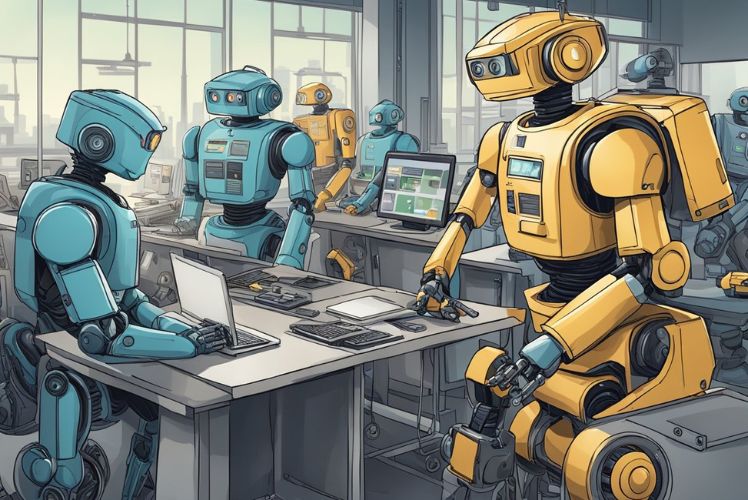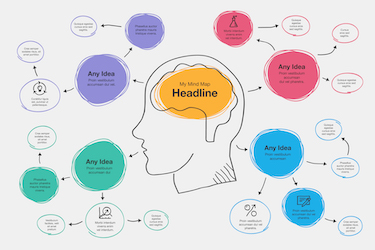The rise of technology has sparked a major discussion about the future of jobs. As robots and artificial intelligence continue to advance, many are left wondering, robots may take some jobs, but they will also create new opportunities for workers. Understanding this balance is crucial as we navigate a changing employment landscape.

As automation becomes more common, we must consider how it affects various industries and our workforce. While some roles may be lost, others may emerge, requiring new skills and adaptability. It is vital for us to be informed and prepared for these shifts in the job market.
Opportunities for innovation and collaboration between humans and machines are on the horizon. We can’t ignore the ethical implications and economic impacts of such changes, as they will shape the future of work in profound ways.
Key Takeaways
- Robots may displace some jobs while creating new roles for skilled workers.
- Automation can drive significant economic changes that impact various sectors.
- Preparing for a future with technology requires adaptability and new skill development.
History of Automation and Employment

The evolution of automation has been a key force shaping employment throughout history. From the Industrial Revolution to modern-day robotics, we have seen significant changes in job roles and the nature of work.
Industrial Revolution to Present
The journey of automation began during the Industrial Revolution in the 18th century. The introduction of machinery transformed industries, allowing for mass production. Steam engines and later electric machines enabled factories to operate at unprecedented speeds. This shift created new jobs while rendering some traditional roles obsolete.
As we moved into the 20th century, advancements in technology, such as computerisation, further changed the employment landscape. In recent decades, robots and artificial intelligence (AI) have emerged, automating tasks once performed by humans. In sectors like manufacturing, we see robots performing repetitive tasks with greater efficiency and accuracy.
Impact on Manufacturing Jobs
Automation's impact on manufacturing jobs is both evident and complex. Historical data show that robots can replace a significant number of human workers. For example, studies indicate that one robot may replace around 5.6 human jobs in certain manufacturing settings.
This shift often results in reduced wages and a need for a more skilled workforce. Jobs requiring manual labour are declining, while positions that emphasise technical skills and oversight of automated processes are growing. Adaptation is critical for workers, as we must focus on developing skills that align with the demands of an automation-driven economy.
Current Landscape of Automation

Automation is rapidly changing how we work across different industries. We are witnessing significant shifts as robots and artificial intelligence (AI) transform tasks, leading to both challenges and opportunities in employment.
Industries Most Affected
Manufacturing and logistics are at the forefront of automation. Robots handle repetitive tasks like assembly, packaging, and sorting. This increases efficiency and reduces costs for companies. The healthcare sector is also seeing automation grow, with AI assisting in diagnostics and patient monitoring.
Furthermore, retail is changing, as automated checkouts reduce the need for cashiers. According to a recent report, about 37% of workers expressed concerns about job loss due to automation, particularly in these industries.
Rise of Artificial Intelligence
The rise of AI is reshaping many job roles. Tasks that require data analysis and pattern recognition are increasingly done by AI systems. For instance, customer service jobs may be threatened as chatbots handle inquiries more effectively than human agents.
In May 2023 alone, nearly 4,000 jobs were cut due to AI-driven changes in various companies. While AI boosts productivity, it also fuels worries over the future of many roles. We need to adapt to these shifts to remain relevant in our careers.
Examples of Automation in Various Sectors
Automation is not limited to specific industries. In agriculture, robotic systems now handle planting and harvesting, reducing labour costs. In finance, algorithms are used for trading and risk assessment.
Even the education sector is seeing changes. AI tools provide personalised learning experiences, reshaping how students engage with content. The diverse applications of automation indicate that its influence is growing across all fields.
As we explore these changes, it’s essential for us to understand how they shape our workforce and what skills will be needed for future jobs.
Economic Impact of Automation

As automation advances, we face significant changes in the workforce. Understanding the economic impact involves examining job displacement and creation, the effects on inequality and economic disparity, and the role of government policies and regulations.
Job Displacement vs Job Creation
We see both job loss and new employment opportunities due to automation. It is estimated that a significant percentage of jobs could be at risk. For example, a report indicates that up to 46% of jobs could be vulnerable for those with just GCSE-level education in the UK. Yet, automation also creates jobs, particularly in technology and maintenance sectors.
Key points about job shifts:
- Routine tasks are more likely to be automated.
- New opportunities arise in fields such as AI, data analysis, and programming.
- Workers may need reskilling to transition into new roles.
Inequality and Economic Disparity
As robots and automation become widespread, we risk increasing economic inequality. Those with high skills may benefit, while low-skilled workers face higher unemployment rates. For instance, job security primarily affects workers in manufacturing, where automation has taken root.
Factors contributing to this disparity include:
- Wage declines: Studies show wages can drop by nearly 0.42% for every additional robot per 1,000 workers.
- Skills gap: Workers need to adapt to the changing job market, which can increase the divide.
- Access to education: Those with limited educational backgrounds may find it harder to compete in the job market.
Government Policies and Regulation
Government intervention is vital to manage the effects of automation on the workforce. Policies can help mitigate job loss and support affected workers. This includes:
- Reskilling programs: Initiatives to help displaced workers gain new skills.
- Support for innovation: Encouraging technological advancements while ensuring fair opportunities.
- Safety nets: Programs to assist those facing unemployment due to automation.
Effective regulation can foster a balanced approach, ensuring we harness the benefits of automation while protecting our workforce. We need to advocate for policies that address these changes and promote inclusive growth in our economy.
The Human Element in a Robot Economy

As automation and robots become more common in various industries, the role of human skills becomes increasingly important. We need to recognise how unique human traits can complement technology, ensuring a balanced relationship between robots and workers.
Job Roles Requiring Human Skills
Certain job roles are better suited to humans due to our unique abilities. Positions in healthcare, education, and creative fields depend heavily on empathy, critical thinking, and complex problem-solving skills. For instance, doctors and nurses need to build trust with patients, something robots cannot replicate. Similarly, teachers rely on emotional intelligence to engage students effectively.
Moreover, jobs that involve strategic planning and decision-making, such as management roles, require human insight. These roles often encompass scenarios where emotions and social understanding play a critical part, reinforcing our value in a technology-driven economy.
Education and Reskilling
To thrive in this evolving job landscape, we must focus on education and reskilling. Some jobs may disappear, but new opportunities will emerge. Investing in our skills through continuous learning will help us adapt to changes brought about by automation.
Subjects like science, technology, engineering, arts, and mathematics (STEAM) are vital. They not only prepare us for technical roles but also foster creativity and innovation.
Vocational training can help individuals gain practical skills needed for new job roles. Programs focusing on soft skills, like communication and teamwork, are essential for preparing us for collaboration with robots in the workplace.
Human and Robot Collaboration
The future likely lies in collaboration between humans and robots, combining the strengths of both. Robots can handle repetitive tasks, increasing efficiency and accuracy. In contrast, we bring creativity, empathy, and the ability to understand complex situations.
For example, in manufacturing, robots can assist in assembling products while we oversee quality control and market strategy. This partnership can lead to higher productivity and improved job satisfaction.
As we embrace this new economy, our ability to work alongside machines will be key. Fostering a collaborative environment will ensure that both robots and humans contribute positively to the workplace, creating a balanced and innovative future.
Preparing for the Future Workforce
As we look towards the future workforce, it is vital to focus on education, adaptability, and career choices. By enhancing our skills and understanding the landscape of automation and artificial intelligence, we can navigate the changes ahead effectively.
Importance of STEM Education
STEM education is crucial for preparing us for future careers. It stands for Science, Technology, Engineering, and Mathematics. Jobs in these fields are often at the forefront of technological advancement.
Benefits of STEM Education:
- Problem-Solving Skills: STEM promotes critical thinking and innovation.
- Job Opportunities: Many high-demand roles require a strong foundation in these subjects.
As technology continues to evolve, skills learned through STEM can lead us to positions that are less likely to be automated. This knowledge equips us to tackle complex challenges in the workforce.
Lifelong Learning and Adaptability
Lifelong learning is essential in a world where automation is changing job requirements. We must embrace continuous education to stay relevant.
Ways to Foster Lifelong Learning:
- Online Courses: Many platforms offer courses that update our skills.
- Networking: Engaging with industry professionals helps us learn about trends.
Adaptability is equally important. As new technologies, like artificial intelligence, emerge, we need to adjust our skills accordingly. Embracing change and being willing to learn can significantly enhance our job security.
Career Paths Less Susceptible to Automation
Certain careers are more resistant to automation and still require a human touch. Understanding these paths can guide our career choices.
Careers Less Affected by Automation:
- Healthcare Workers: Roles like doctors and nurses require empathy and complex decision-making.
- Creative Professionals: Artists, writers, and designers rely on human creativity, which machines can't replicate.
- Educators: Teachers foster interpersonal relationships and adapt to students' needs, a role machines cannot fulfil.
Choosing careers in these fields may provide us with greater job stability in the face of automation. We should consider these options as we plan our future.
Technological Innovations and Startups
Innovations in technology and the rise of startups are driving automation forward. We observe how these new businesses leverage artificial intelligence and robotics to create efficient solutions across various sectors.
Startup Ecosystem Supporting Automation
The startup ecosystem is vibrant, with many firms focusing on automation. These startups often combine robotics and artificial intelligence to enhance productivity.
Investment in such companies has surged. For instance, venture capital is flowing into businesses that develop AI-driven tools. These tools help in industries like manufacturing, logistics, and healthcare.
Many startups also focus on simplifying processes. This can mean automating repetitive tasks, which allows human workers to focus on more complex duties.
Prominent examples include those developing autonomous delivery systems and robotic process automation software. This wave of innovation indicates a shift towards a more automated future.
Case Study: Arterys
Arterys is a leading example of innovation in the healthcare sector. They specialise in using artificial intelligence to assist radiologists.
Their technology analyses medical images with remarkable speed and accuracy. By automating this process, Arterys helps doctors make faster diagnoses. This is crucial in a field where timely interventions can save lives.
The platform’s AI algorithms compare scans to vast databases. This ensures that anomalies are quickly identified, which improves patient outcomes.
With their focus on integrating AI into traditional practices, Arterys stands as a model for how startups can transform industries. Their success showcases the potential for technology to not only aid professionals but also to change how we think about job roles in medicine.
Ethical Considerations and Society
As automation becomes more common, we face important ethical questions. These include the implications of robots and artificial intelligence on employment, the effect on workers, and how our laws adapt to these changes.
The Role of Ethics in Automation
Ethics plays a crucial role in how we implement robots and AI. We must consider the moral responsibilities of companies that adopt these technologies. A key question is whether businesses should prioritise profit over the welfare of their employees.
When designing automation systems, we should ensure that they do not exploit workers or erode job security. This also includes transparency about how AI makes decisions that could affect people's lives.
To approach these issues, we can establish ethical guidelines to guide the development and deployment of technology in the workplace. By involving various stakeholders, we can create a more balanced perspective that respects both innovation and human dignity.
Societal Impact of Displaced Workers
The rise of automation directly affects employment across various sectors. Workers in routine jobs may find themselves displaced as robots take over their tasks. This shift can lead to increased unemployment and a sense of insecurity among the workforce.
We see a growing need for reskilling and upskilling programs to help displaced workers transition to new roles. It’s vital for our society to invest in education and training initiatives that prepare workers for the changing job landscape.
Moreover, the emotional and psychological effects on displaced workers cannot be overlooked. It is our responsibility to support individuals through their career transitions and provide assistance to those who struggle to adapt to new career paths.
Legal Framework and Workers' Rights
As AI and robots change the workplace, our legal frameworks must evolve to protect workers’ rights. Existing labour laws may not adequately address issues like job displacement and privacy concerns linked to automation.
We need to advocate for updated regulations that ensure fair treatment and job security in an increasingly automated environment. This could include policies that require companies to invest a portion of savings from automation back into employee training programs.
Additionally, ensuring that workers have a voice in discussions about automation is vital. This might involve collective bargaining agreements or the establishment of committees where employees can express concerns about AI and robotics at work. By prioritising workers’ rights, we can create a fairer future for everyone.
Frequently Asked Questions
In this section, we address common questions related to the impact of robotics and artificial intelligence on employment. We will explore which professions are most affected and how individuals can adapt to these changes.
What professions are at highest risk of automation?
Jobs involving repetitive tasks are often at the highest risk of automation. This includes roles in manufacturing, data entry, and customer service. Positions that require minimal emotional intelligence or complex decision-making are also vulnerable.
How likely is it that artificial intelligence will displace human employment?
Research suggests that a significant number of jobs could be affected by AI in the coming years. While some studies predict that millions of jobs may be displaced, others indicate that new roles will emerge, balancing the overall impact on employment.
Which careers are considered robot-proof and cannot be automated?
Certain professions are less likely to be automated. These include jobs in healthcare, education, and creative industries. Roles that require high levels of social interaction, empathy, and critical thinking are typically more secure.
By what year is it expected that a significant number of jobs will be lost to automation?
Analysts forecast that by 2025, millions of jobs could be displaced by automation technologies. Reports estimate that around 85 million jobs may be lost, but also about 97 million new roles could arise in areas related to these technologies.
What are the implications of robotics on the future job market?
The rise of robotics is likely to change the job market significantly. We may see a shift in demand for certain skills, with an emphasis on technology, creativity, and interpersonal skills. Additional training and education will be essential in adapting to these changes.
How can individuals prepare for the impact of robotics on employment opportunities?
Individuals can enhance their adaptability by investing in education and skill development. Embracing lifelong learning will help us stay relevant in an evolving job market. Focusing on skills that complement technology, rather than compete with it, will be crucial.





















